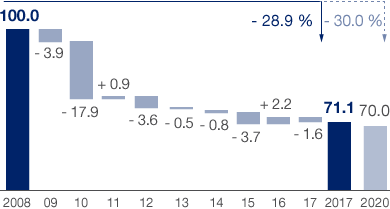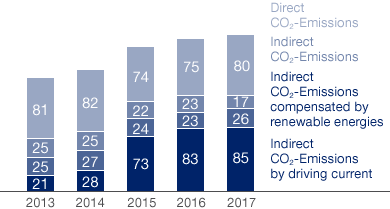Emissions and Energy
HHLA has reported on its carbon footprint regularly since 2008 as part of the international Carbon Disclosure Project (CDP). The CDP is a non-profit initiative that manages one of the world’s largest databases of corporate greenhouse gas emissions on behalf of institutional investors and makes this information available to the public.
HHLA calculates its CO2 emissions on the basis of the Greenhouse Gas Protocol Corporate Standard (revised edition), a global standard for recording greenhouse gas emissions. Within the HHLA Group, emissions mainly relate to CO2. These are primarily influenced by throughput and transport volumes, traction services provided by the Group’s own locomotives and the use of electricity from renewable sources. In line with the Greenhouse Gas Protocol, electricity procured separately from renewable energy sources was classified as carbon-neutral for the calcualting the specific emissions. In the calculation of absolute emissions, the CO2 emission quantity, which is lower due to the use of electricity from renewable energy sources, is reported separately.
The power needed by a terminal depends largely on the number of seaborne containers it handles and the number of containers transported over land by rail and truck. HHLA uses seaborne and onshore throughput in containers as an effective indicator to determine specific CO2 emissions in line with the recommendations of the European Economics Environment Group (EEEG). HHLA has set itself the target of reducing specific CO2 emissions – the CO2 emissions per container handled – by at least 30 % by 2020. The 2008 figures serve as the baseline here. In the period from 2008 to 2017, the company succeeded in reducing CO2 emissions by 28.9 % per container handled. Specific CO2 emissions fell by 2.2 % in the year under review.
Changes in Specific CO2 Emissions since 2008
Climate protection target: 30 % reduction by 2020

Direct and Indirect CO2 Emissions
in thousand tonnes

The three-year average annual, specific CO2 emission development is one of the targets agreed with the Executive Board and taken into account when determining Executive Board remuneration. Achieving the agreed target range triggers the payment of a corresponding bonus. see also Corporate Governance/Remuneration Report
Absolute CO2 emissions increased year-on-year by 2.1 % or 4,296 tonnes to 208,697 tonnes, excluding 26,246 tonnes of CO2 emissions from the purchase of electricity generated using renewable energy sources. This slight rise is mainly attributable to the higher utilisation of the Metran fleet of environmentally friendly electric multi-system locomotives. Traction-related emissions increased by 2.7 % or 2,268 tonnes from 82,867 tonnes to 85,136 tonnes. The strong increase in throughput at the four container terminals operated by HHLA prompted a 7.0 % rise in CO2 emissions there in the reporting year – excluding the use of electricity from renewable energy sources – raising the figure by 6,385 tonnes to 97,074 tonnes.
|
2013 |
2014 |
2015 |
2016 |
2017 |
|||||||||
|
||||||||||||||
Diesel and heating oil in million litres |
27.7 |
29.2 |
26.3 |
26.6 |
27.4 |
|||||||||
Natural gas in million m3 |
3.1 |
1.8 |
2.3 |
2.4 |
3.6 |
|||||||||
Electricity1 in million kWh |
148.7 |
154.4 |
138.3 |
139.6 |
135.6 |
|||||||||
thereof from renewable energies |
78.0 |
84.1 |
76.1 |
73.2 |
82.8 |
|||||||||
Traction current in million kWh |
37.9 |
51.7 |
130.3 |
150.0 |
157.5 |
|||||||||
District heating in million kWh |
4.6 |
3.7 |
3.2 |
3.6 |
3.6 |
|||||||||
Within the various HHLA companies, a number of projects to increase energy efficiency were conducted during the reporting period. Steps were taken to control energy-consuming components and lighting systems in line with demand.
A long-term increase in the percentage of electricity used within the Group’s energy mix will enable the company to utilise more renewable energies and thereby substantially reduce its carbon footprint. HHLA is therefore converting more and more of its equipment and machinery at the terminals to electricity. Such equipment and machinery produces fewer emissions and less noise and is also easier to service. The electricity required by all office buildings and workshops in Hamburg occupied by HHLA, the Container Terminal Altenwerder (CTA) and the all-electric yard crane system at the Container Terminal Burchardkai (CTB) comes from renewable energy sources. In the reporting year, additional quantities of renewable energies were procured, largely to compensate for CO2 emissions from the operation of a CHP unit. In the reporting period, these measures reduced CO2 emissions by 26,246 tonnes (previous year: 23,190 tonnes). A photovoltaic system at the Container Terminal Tollerort (CTT) installed and operated by the energy supplier Hamburg Energie Solar produced 103,590 kWh of CO2-free electricity in the reporting period.
Energy-efficient equipment, systems, machinery and processes not only reduce local emissions, but also have economic benefits. With this in mind, HHLA pays particular attention to the use of energy-efficient, low-emission machinery and equipment when it makes new and replacement investments. In 2017, the fleet of all-electric cars grew to 79. HHLA’s electric vehicles are powered by renewable electricity and are a quiet, low-maintenance solution that do not generate any local emissions. The electric vehicles cover a distance of some 500,000 km each year, which reduces CO2 emissions by approximately 160 tonnes.
Work to modernise the straddle carrier fleet at the Container Terminal Burchardkai (CTB) continued with the acquisition of 16 new straddle carriers. These large machines comply with the strict requirements of the European Union’s Euro 4 emissions standard. With their extremely low emissions of nitrogen oxides and particulate matter, they make an important contribution towards reducing emissions of harmful substances at the container terminal. Meanwhile, on the rails, another shunting hybrid locomotive for heavy goods trains has been running on the tracks of the Hamburg port railway since the reporting year. The locomotive is used by HHLA subsidiary METRANS. The modern hybrid drive with an electric motor and diesel engine reduces consumption by over 50 %.
In addition, the computer-aided optimisation of container storage positions minimises the distance travelled by transport equipment, thereby reducing energy consumption and noise pollution. Resource usage is improved by cleaning used hydraulic oils and diesel fuels from tanks on site and reusing them.
Consumption of traction current within HHLA has risen markedly in recent years due to a significant increase in the use of the company’s own traction fleet for rail transportation. In addition to cutting-edge multi-system locomotives, the engine driver’s style can influence the amount of traction current used. In order to improve this aspect, a training programme for energy-efficient driving was developed and launched for engine drivers in reporting period.
The energy management system that was certified according to DIN ISO 50001 for Hamburger Hafen und Logistik AG and HHLA Personal Service GmbH in the previous year has been extended to Fischmarkt Hamburg-Altona GmbH. All HHLA companies in Germany and Poland with significant energy consumption have now adopted the energy management system.
The action of a locomotive pulling a train.
In maritime logistics, a terminal is a facility where freight transported by various modes of transport is handled.
In maritime logistics, a terminal is a facility where freight transported by various modes of transport is handled.
Payments for investments in property, plant and equipment, investment property and intangible assets.
A vehicle used to transport containers at the terminals. The driver manoeuvres their straddle carrier into position above a container and lifts it up. The vehicles can stack containers up to four high.
The action of a locomotive pulling a train.